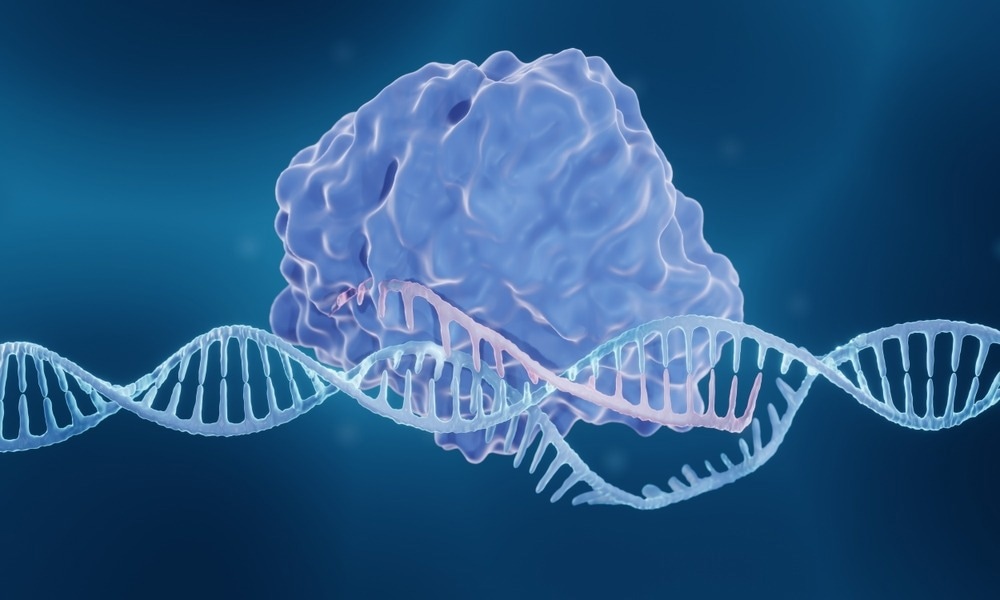Reviewed by Danielle Ellis, B.Sc.Jan 22 2024
Through the use of CRISPR, an immune system that bacteria use to defend themselves against viruses, researchers have been able to alter genetic information within cells.

Image Credit: ART-ur/Shutterstock.com
As a matter of fact, the FDA recently approved the first CRISPR-based therapeutic to treat sickle cell disease in December 2023. The CRISPR-Cas9 genetic scissors, a thoroughly researched system, serve as the foundation for that treatment.
But Type I CRISPR, also known as CRISPR-Cas3, is a more recent and innovative platform that holds promise for large-scale DNA removals. It is currently being developed for possible therapeutic applications.
Yan Zhang, PhD, an Assistant Professor in the University of Michigan Medical School's Department of Biological Chemistry, and Cornell University colleagues have developed off-switches that could enhance the Type I-C/Cas3 gene editor's safety. The research has been published in the Molecular Cell journal.
The Zhang team creates CRISPR off-switches from anti-CRISPR proteins that phages have evolved to counteract bacterial CRISPR immunity, taking advantage of the arms race between bacteria and viruses that infect them (bacteriophages).
In experimental settings, anti-CRISPR proteins that block Cas9 have been employed to lessen the “off-target” effects of CRISPR. These effects are caused by Cas9 acting on non-targeted, unintentional areas of the body or genome and making unwanted edits that could have negative consequences like an elevated risk of cancer.
When editing human genome using CRISPR-Cas9, providing an inhibitor protein can helps mitigate off-target effects and increase the safety profile. This is because off-targets tend to occur when there is an excess of CRISPR reagents or that they linger in the cells for too long. Applying inhibitors to restrict the amount or duration of CRISPR action has proven to be effective in reducing off-target edits while maintaining on-target edits.”
Yan Zhang, Assistant Professor, Department of Biological Chemistry, University of Michigan Medical School
The goal of the Zhang team was to create a reliable off switch for the extremely effective Cas3 system they had previously discovered in Neisseria lactima, a type of bacteria that is harmlessly found in the upper respiratory tract of humans. After going through every anti-CRISPR that has been identified and documented in the literature as an inhibitor of other Cas3 variants from different bacterial organisms, researchers discovered two - AcrIC8 and AcrIC9 - that had a potent cross-reaction with Neisseria Cas3.
Next, the team wanted to know more about how they work because “how they work will inform what kind of Cas3-based technologies can be controlled by each anti-CRISPR.”
Yan Zhang, Assistant Professor, Department of Biological Chemistry, University of Michigan Medical School
Through genetic and biochemical research at U-M and cryogenic electron microscopy analysis at Cornell, they were able to ascertain the molecular structure and mechanism of action of AcrlC8 and AcrlC9. The CRISPR-Cas3 machine is prevented from binding to its DNA target site by both proteins, albeit through slightly different mechanisms, researchers reported.
To see this at an atonic level from Ke lab’s work is truly astonishing and they are employing a very clear strategy —competing with the DNA to be bound by the Cas machinery, a very effective way to block Cas protein function.”
Yan Zhang, Assistant Professor, Department of Biological Chemistry, University of Michigan Medical School
Ultimately, the Zhang group presented important proof-of-concept data demonstrating that every one of these anti-CRISPR proteins can function as a CRISPR-Cas3 off-switch in human cells. These are the first off-switches for any CRISPR-Cas3 gene editor that have been developed because they can virtually completely block two different versions of the technology: one for large genome deletion and the other for gene activation.
Zhang says, “Cas3 with an off switch would be a safer way to engineer the genome.”
Zhang lab plans to further develop CRISPR-Cas3 based therapeutics for various human diseases, with the newly discovered off switches, in collaboration with colleagues here at U-M Medical School.
Chunyi Hu, PhD of Cornell University, and PhD Student Mason Myers of U-M are the first authors of the manuscript.
Zhang concludes “It has been extremely gratifying to watch Mason’s exponential growth as a budding young scientist. As a third-year PhD student in my group, he has already shown so much potential.”
Ailong Ke, PhD, Robert J. Appel Professor in Molecular Biology and Genetics at Cornell University is a co-corresponding author on this paper.
Source:
Journal reference:
Hu, C., et al. (2024) Exploiting activation and inactivation mechanisms in type I-C CRISPR-Cas3 for genome-editing applications. Science Direct. doi.org/10.1016/j.molcel.2023.12.034